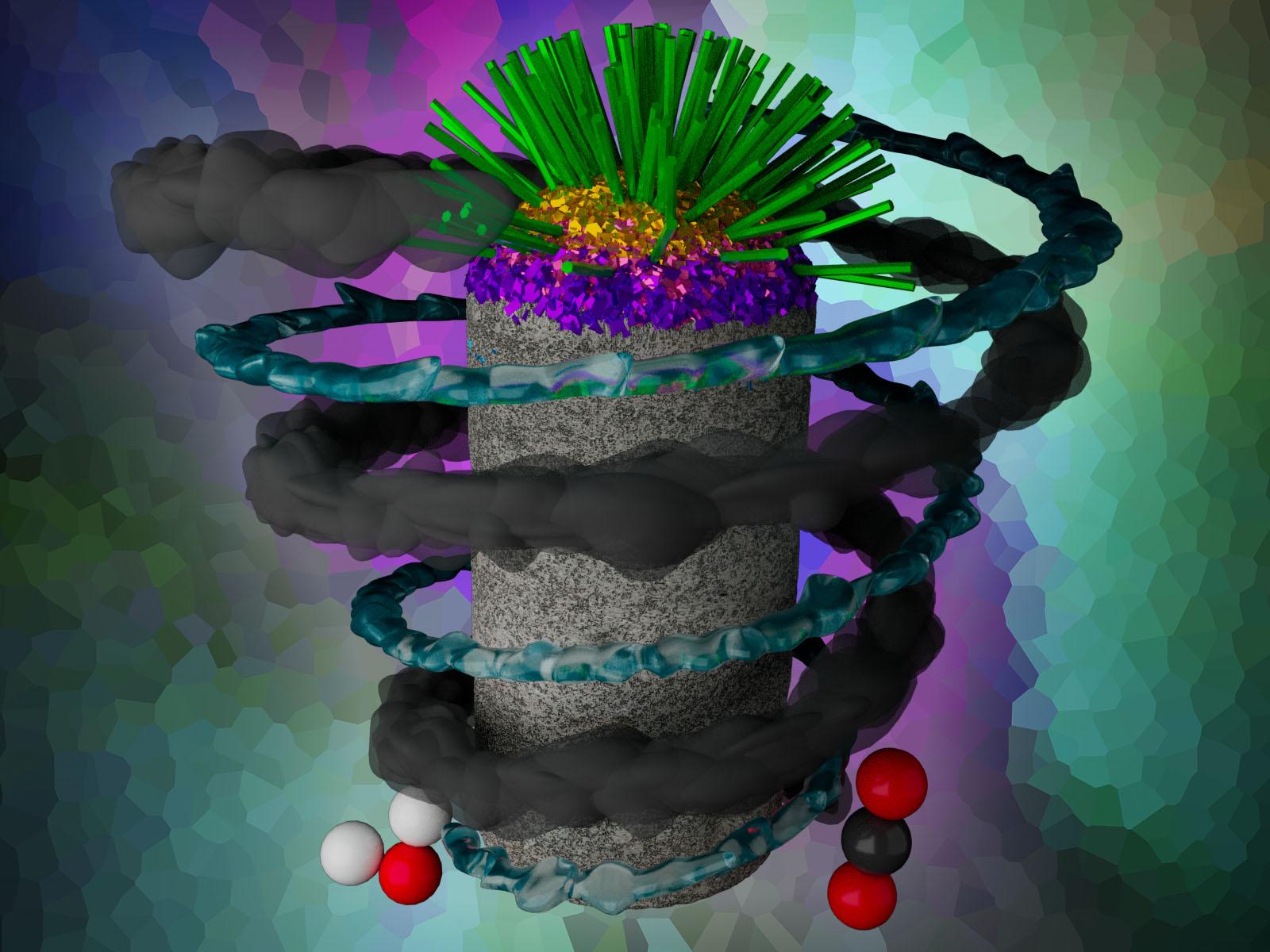Identifying Key Research Directions for Predictive Carbon Mineralization at Nanoconfined Interfaces
A review article examines a decade of work on the process of turning carbon dioxide into stable minerals

CO2 and H2O coalesce at host rock surfaces, triggering dissolution and reprecipitation of diverse metal carbonate minerals.
(Image by Cortland Johnson | Pacific Northwest National Laboratory)
The Science
Many human activities and industries release carbon dioxide (CO2), a greenhouse gas that traps light energy in the atmosphere. As CO2 levels have risen, so have temperatures. One alternative to emitting CO2 is capturing and storing it. Because CO2 stored underground as a gas may leak, researchers have been exploring carbon mineralization, the conversion of CO2 into a solid mineral, as a storage stragegy. A new review article summarizes the latest decade of work focused on understanding carbon mineralization outcomes in nanoscale adsorbed water films on mineral surfaces. It points to the importance of understanding the factors that control the speciation and movement of dissolved CO2 and released metal ions in these quasi-2-dimensional interfacial environments.
The Impact
Storing CO2 in stable forms is essential for mitigating its effects on the global climate. To gain control of carbon mineralization at industrially relevant scales, researchers first need to understand how the process occurs at a molecular level. This review article provides a basis for creating the efficient mineralization systems necessary to maximize long-term storage potential. The findings have implications for both natural and engineered environments, as well as broader relevance to separation science and energy storage.
Summary
Rocks that contain divalent metals, like basalts, can react with human-created CO2 and lead to permanent storage. This storage occurs when the CO2, water, and metals in the rock react to form stable carbonate materials. A new review specifically examines what happens when CO2 and water react at rock surfaces in thin water films. Here, water acts as a quasi-2-dimensional film that effectively confines the carbon mineralization environment. This creates unique interfacial properties that influence the kinetics and mechanisms of carbonate formation. Developing a deeper understanding of the fundamental properties of carbon mineralization can lead to better controlled carbon storage.
This research is an important component of developing the highly stable carbon storage needed to reach net-zero carbon goals.
PNNL Contact
Kevin Rosso, Pacific Northwest National Laboratory, kevin.rosso@pnnl.gov
Funding
This material is based on work supported by the Department of Energy (DOE), Office of Science, Basic Energy Sciences (BES) program, Chemical Sciences, Geosciences, and Biosciences Division through its Geosciences program at Pacific Northwest National Laboratory (PNNL) and at the University of California Irvine through an Early Career award to MJAQ (DE-SC0022301). HTS acknowledges support from Darin Damiani (DOE HQ) and the Carbon Utilization and Storage Partnership (CUSP). JPK acknowledges support from the John and Jane Wold Centennial Chair in Energy and from a Nielson Energy Fellowship. Any opinions, findings, conclusions, or recommendations expressed in this material are those of the authors and do not necessarily reflect those of the funding agency.
Published: November 7, 2022
Qomi, M. J., Miller, Q. R. S., Zare, S., Schaef, H. T., Kaszuba, J. P., & Rosso, K. M. 2022. “Molecular-Scale Mechanisms of CO2 Mineralization in Nanoscale Interfacial Water Films,” Nature Reviews Chemistry, 6, 598-613. [DOI: 10.1038/s41570-022-00418-1]